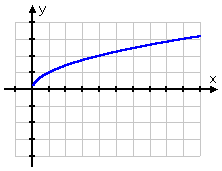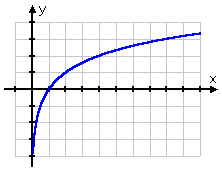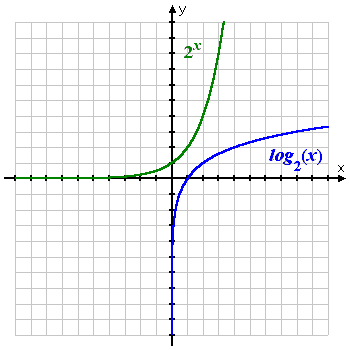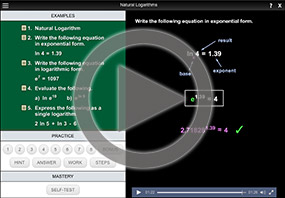History & The Natural Log
Purplemath
A logarithm can have any positive value (other than 1) as its base, but logs with two particular bases are generally regarded as being more useful than the others: the "common" log with a base of 10, and the "natural" log with a base of the number e.
Content Continues Below
(There is also the base-2 log, favored by computer-science types, because computers are built on the base-two binary system.)
What is the common log?
The common log is the base-10 log. It was also the first form of logarithm, back when logs were invented. The common log is popular for historical reasons, and is usually written as log(x); that is, without the base being included. For instance, pH (being the measure of a substance's acidity or alkalinity), decibels (being the measure of sound intensity), and the Richter scale (being the measure of earthquake intensity) all involve base-10 logs.
So if a log has no base written, you should generally (at least in your algebra classes) assume that the base is 10. (This is similar to the assumption we make when a radical has no index included; that is, we assume [correctly] that the radical is a square root.)
What is the natural log?
The natural log is the base-e log, where e is the natural exponential, being a number that is approximately equal to 2.71828. The natural log has its own notation, being denoted as ln(x) and usually pronounced as "ell-enn-of-x". (Note: That's "ell-enn", not "one-enn" or "eye-enn".) Just as the number π arises naturally in geometry, so also e arises naturally in math and the sciences. As a result, the natural log is common in science and finance, which is why you need to be familiar with it.
Because the common and natural logs are pretty much the only logs that are used "in real life", these are the only two for which you have calculator keys. Make sure you know where these keys are, and how to use them.
Affiliate
What is the difference between "log" and "ln"?
The difference between "log" and "ln" is their bases. The "log" has a base of 10 and the "ln" has a base of e ≈ 2.71828.
Why the natural log's notation is ln rather than nl
Why would the natural log be denoted by ln, rather than by "nl"? One popular idea relates to Euler (his name is pronounced as "OY-lur"), who was one of the guys connected to the natural exponential. Euler was Swiss and spoke French, so he might have called the function "le Logarithme Naturel", rather than "the natural log", in which case, ln makes sense. However, history shows that Euler actually used the notation "l(x)" for the logarithm using "his" number e as its base.
Advertisement
Some think the notation came from the use of Latin (which had been in common use among European scholars) for "natural log", the Latin being "logarithmus nātūrālis". I'm not aware of any evidence for this, though.
The first published use of the ln notation for the base-e logarithm is generally regarded as being Stringham's, in his 1893 text "Uniplanar Algebra". Prof. Stringham was an American, so I have no idea why he would have used the notation ln, other than perhaps to reflect a common, though mistaken, idea that Napier's log was a base-e log. That is, "ln" might have meant to stand for "Log of Napier".
On the other hand, the German mathematician Anton Steinhauser appears to have proposed using ln.a to mean "the natural log of a" ("logarithmus naturalis a") in 1875.
Mercator (not the map guy) used a Latin form of the term, log naturalis, in his 1668 book on logarithms, and, as of the late 1800s, various English-speakers were using the notation log.nat. for the natural logarithm. In short, the origin of this notation seems somewhat obscure, perhaps even unknown — which is unusual for such a recent invention.
Content Continues Below
Why is the natural log so special?
The base of the natural log is the number e, which is approximately equal to 2.71828. This number arises naturally in many areas of math and the sciences, just as π arises naturally in geometry and trigonometry. The natural log and natural exponential are crucially important in calculus. There is something about the universe that makes the existence of e and π unavoidable. And e carries the seeds of the natural log within it, making its discovery inevitable.
You can't do geometry without π; you can't do the sciences without e and the natural log.
When you're doing simplification or evaluation of logs without a calculator, you will be expected to know that a log with no base written is the common (that is, the base-10) log, and that ln indicates the natural (that is, the base-e) log.
- Simplify log(100).
There is no base displayed on this log, so it is the common, or base-10, log. Setting the given log expression equal to a variable, I get:
log(100) = y
10y = 100 = 102
Then my hand-in answer is:
log(100) = 2
To do this in your calculator, plug "log(100)" into your calculator — using the log key, not the ln key — and you'll get the same answer.
- Simplify log(98). Round your answer to two decimal places.
Unfortunately, the number 98 is not a nice neat power of 10 the way that 100 was. So I cannot be clever with exponents to arrive at an exact answer.
Instead, on this exercise, I am stuck with using my calculator to get an approximate value. So I'll plug this into my calculator, remembering to use the log key (not the ln key). Plugging into the software, I get a value of log(98) = 1.99122607569..., or, rounded to two decimal places:
log(98) = 1.99
- Simplify ln(e4.5)
Affiliate
I remember that the ln( ) notation means that the base of the log is the natural exponential, e, so this is the natural log.
The base e of the natural log is not a nice neat whole number. Pretty much any time I'm given a natural log to evaluate, I'm gonna have to get a decimal approximation from my calculator. I can't do anything clever to get an exact answer. But this is a special case, because the argument of the log includes the natural exponential.
The Relationship says that:
ln(e4.5) = y
e y = e4.5
y = 4.5
So this is one of those faux-cancellation exercises, and my hand-in answer is:
ln(e4.5) = 4.5
Plug "ln(e4.5)" into your calculator, and you'll get the same answer. Just make sure you put parentheses around the argument, e4.5, so the calculator knows that the exponent is inside the log.
- Evaluate ln(2) accurate to two decimal places.
Since 2 is a nice neat whole number and since e isn't, then it is unlikely that 2 is a nice neat power of e. (It isn't.) So I can't simplify this expression by being clever with exponents. Instead, I'll have to evaluate this in my calculator, getting an approximate answer of ln(2) = 0.69314718056..., or, rounded to two decimal places:
ln(2) = 0.69
The graph of a logarithm looks similar to that of a square root.
square-root function

log function

The square-root graph stops at the point (0, 0); the logarithm's graph does not pass through the origin, nor does it ever reach the y-axis. Instead, the log graph passes through the point (1, 0) (on the x-axis) and then continues down along the right-hand (that is, the positive) side of the y-axis.
Since the log function is the inverse of the exponential function, the graph of the log is the flip of the graph of the exponential:

The exponential rides along the top of the x-axis, crosses the y-axis at the point (0, 1), and then shoots up. The logarithm rides up the right side of the y-axis, crosses the x-axis at the point (1, 0), and then shoots right.
(For more information, review the lesson on graphing logarithms.)
URL: https://www.purplemath.com/modules/logs3.htm
You can use the Mathway widget below to practice evaluating logarithms with your calculator. Try the entered exercise, or type in your own exercise. Then click the button to compare your answer to Mathway's. Note: The widget assumes that "log" means "common log" (that is, the base-10 log), unless otherwise specified.To evaluate some other based log, use the widget's log-with-a-subscript-box button.
Please accept "preferences" cookies in order to enable this widget.
(Click "Tap to view steps" to be taken directly to the Mathway site for a paid upgrade.)
Select a Course Below
Standardized Test Prep
Homeschool Math
© 2024 Purplemath, Inc. All right reserved. Web Design by ![]()




